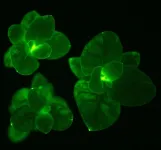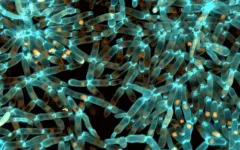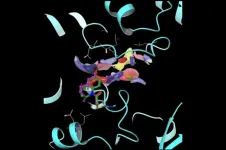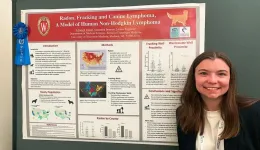(Press-News.org) University of Pittsburgh researchers have uncovered blood-based markers linked with healthy and rapid aging, allowing them to predict a person’s biological age — how fast a person’s cells and organs age regardless of their birthdate.
The new research, published in Aging Cell, points to pathways and compounds that may underlie biological age, shedding light on why people age differently and suggesting novel targets for interventions that could slow aging and promote healthspan, the length of time a person is healthy.
“Age is more than just a number,” said senior author Aditi Gurkar, Ph.D., assistant professor of geriatric medicine at Pitt’s School of Medicine and member of the Aging Institute, a joint venture of Pitt and UPMC. “Imagine two people aged 65: One rides a bike to work and goes skiing on the weekends, and the other can’t climb a flight of stairs. They have the same chronological age, but very different biological ages. Why do these two people age differently? This question drives my research.”
Towards answering this question, Gurkar and her team compared 196 older adults who they classified as healthy or rapid agers by how easily they completed simple walking challenges. Because walking ability is a holistic measure of cardiovascular fitness, physical strength and neurological health, other studies have shown that it’s the single best predictor of hospitalization, disability, functional decline and death in older adults.
Healthy agers were 75 years or older and could ascend a flight of stairs or walk for 15 minutes without resting, and the rapid agers, who were 65 to 75 years old, had to rest during these challenges.
According to Gurkar, this study is unique because the rapid agers were chronologically younger than the healthy agers, allowing the researchers to home in on markers of biological — not chronological —aging, unlike other studies that have compared young adults with older people.
To define a molecular fingerprint of biological aging in blood samples from participants, they performed metabolomics — an analysis of metabolites, molecules that are produced by chemical pathways in the body — with blood samples from the two groups.
“Other studies have looked at genetics to measure biological aging, but genes are very static: the genes you’re born with are the genes you die with,” said Gurkar. “We chose to look at metabolites because they are dynamic: They change in real time to reflect our current health and how we feel, and we have the power to influence them through our lifestyles, diet and environment.”
Healthy and rapid agers showed clear differences in their metabolomes, indicating that metabolites in the blood could reflect biological age.
Gurkar and her team next identified 25 metabolites that they termed the Healthy Aging Metabolic (HAM) Index. They found that the HAM Index was better than other commonly used aging metrics — including the frailty index, gait speed and the Montreal Cognitive Assessment test — at distinguishing healthy and rapid agers.
To validate their new index, the researchers analyzed a separate cohort of older adults from a Wisconsin-based study. The HAM index correctly predicted whether individuals could walk outside for 10 minutes without stopping with accuracy of about 68%.
“We took a very different cohort of people from a different geographical region, and we saw the same metabolites were associated with biological aging,” said Gurkar. “This gives us confidence that the HAM Index can truly predict who is a healthy ager versus a rapid ager.”
Using an artificial intelligence model that can predict potential drivers of biological traits, the team identified three main metabolites that were most likely to promote healthy aging or drive rapid aging. In future research, they plan to delve into how these metabolites and molecular pathways that produce them contribute to biological aging and explore interventions that could slow this process.
Gurkar is also planning more research to evaluate how the metabolome of younger people shifts over time. Eventually, she hopes to develop a blood test that could estimate biological age in young adults or predict those who might go on to develop diseases of aging.
“While it’s great that we can predict biological aging in older adults, what would be even more exciting is a blood test that, for example, can tell someone who’s 35 that they have a biological age more like a 45-year-old,” Gurkar said. “That person could then think about changing aspects of their lifestyle early — whether that’s improving their sleep, diet or exercise regime — to hopefully reverse their biological age.”
“Today, in medicine, we tend to wait for a problem to occur before we treat it,” she added. “But aging doesn’t work that way — it’s about prevention. I think the future of medicine is going to be about knowing early on how someone is aging and developing personalized interventions to delay disease and extend healthspan.”
Other authors on the study were Shruthi Hamsanathan, Ph.D., Tamil Anthonymuthu, Ph.D., Denise Prosser, Anna Lokshin, Ph.D., Susan L. Greenspan, M.D., Neil M. Resnick, M.D., Subashan Perera, Ph.D., and Satoshi Okawa, Ph.D., all of Pitt or UPMC; and Giri Narasimhan, Ph.D., of Florida International University.
This research was supported in part by the Pittsburgh Claude D. Pepper Older Americans Independence Center (P30 AG024827). The Gurkar Lab is supported through the National Institutes of Health (R00 AG049126, R01HL161106, U54AG075931, P30CA047904, R01AG054047 and RF1AG054047), the National Academy of Medicine Catalyst grant, AFAR/Hevolution and the R.K. Mellon Foundation.
END
New study reveals molecular fingerprint of biological aging
2024-03-08
ELSE PRESS RELEASES FROM THIS DATE:
Glowing flowers illuminate homes and gardens with organic light
2024-03-08
Sun Valley, ID - March 8, 2024 – Recent discoveries published in Science Advances have unveiled a native plant gene that enables researchers to more effortlessly harness the captivating glow of bioluminescent plants. This gene, which varies across different plant species, allows for the redirection of living energy into organic light. The advancement reveals the intricate inner rhythms and dynamics of plants through continuously evolving luminosity, offering a natural source of illumination for homes, gardens, and beyond.
The study received support from Light Bio, a pioneer in the development of bioluminescent plants. Light Bio is dedicated to fostering ...
Research sheds light on new strategy to treat infertility
2024-03-08
New research from Oregon Health & Science University describes the science behind a promising technique to treat infertility by turning a skin cell into an egg that is capable of producing viable embryos.
Researchers at OHSU documented in vitro gametogenesis, or IVG, in a mouse model through the preliminary steps of a technique that relies upon transferring the nucleus of a skin cell into a donated egg whose nucleus has been removed. Experimenting in mice, researchers coaxed the skin cell’s nucleus into reducing its chromosomes by half, so that it could then be fertilized ...
The brain builds emotions regardless of the senses
2024-03-08
How much do our emotions depend on our senses? Does our brain and body react in the same way when we hear a fearful scream, see an eerie shadow, or smell a sinister odor? And does hearing an upbeat music or seeing a colorful landascape bring the same joy?
In an innovative study published in Science Advances, researchers have unveiled new insights into the intricate relationship between emotion and perception.
Led by a team of Italian neuroscientists from the IMT School for Advanced Studies Lucca, and conducted in collaboration with the University of Turin, the research project investigates whether the brain employs sensory-specific or abstract codes to construct ...
Harnessing the mechanisms of fungal bioluminescence to confer autonomous luminescence in plants and animal cells
2024-03-08
In a striking new study published today in Science Advances, a team of synthetic biologists led by Karen Sarkisyan at the MRC Laboratory of Medical Sciences, have reported the discovery of multiple plant enzymes – hispidin synthases – that can perform the most complex reaction of the bioluminescence pathway. This discovery is a significant milestone towards figuring out whether plants can natively produce all the molecules required for light emission. It also means that the glow of bioluminescent plants can now be more closely aligned with their internal biology.
The technology reported in the paper is a hybrid ...
New study discovers how altered protein folding drives multicellular evolution
2024-03-08
Researchers have discovered a mechanism steering the evolution of multicellular life. They identified how altered protein folding drives multicellular evolution.
In a new study led by researchers from the University of Helsinki and the Georgia Institute of Technology, scientists turned to a tool called experimental evolution. In the ongoing Multicellularity Long Term Evolution Experiment (MuLTEE), laboratory yeast are evolving novel multicellular functions, enabling researchers to investigate how they arise.
The study puts the spotlight on the regulation of proteins in understanding evolution.
"By demonstrating the effect of protein-level ...
Socially prescribed creative play boosts parents’ and children’s wellbeing
2024-03-08
University of Leeds news
For immediate release
Socially prescribed creative play boosts parents’ and children’s wellbeing
Socially prescribed creative play helps children and their parents develop new skills and promotes wellbeing, a new study has found.
The University of Leeds-led study evaluated a five-week programme of arts-based play, including singing and music-making, for families of children aged up to three. It found that parents benefited from developing social networks and sharing experiences with each other, as well as learning creative approaches to parenting. ...
Researchers’ approach may protect quantum computers from attacks
2024-03-08
Quantum computers, which can solve several complex problems exponentially faster than classical computers, are expected to improve artificial intelligence (AI) applications deployed in devices like autonomous vehicles; however, just like their predecessors, quantum computers are vulnerable to adversarial attacks.
A team of University of Texas at Dallas researchers and an industry collaborator have developed an approach to give quantum computers an extra layer of protection against such attacks. Their solution, Quantum Noise Injection for Adversarial Defense (QNAD), counteracts the impact of ...
Rogue enzymes cause numerous diseases. A new method could help design drugs to treat them.
2024-03-08
Helicases are enzymes that unwind DNA and RNA. They’re central to cellular life, implicated in a number of cancers and infections—and, alas, extraordinarily difficult to target with drugs.
Now, new research provides a powerful platform for designing covalent inhibitors tailored to target helicases. The paper, published in the Journal of the American Chemical Society, describes how researchers used this innovative new platform to design molecules that take aim at helicases involved in COVID and certain cancers.
“High-resolution structural and biochemical data alone are not sufficient ...
Study shows how oestrogen protects against fatty liver
2024-03-08
New research from Karolinska Institutet in Sweden shows how oestrogen protects against MASLD, a fatty liver disease that has increased dramatically during the current obesity epidemic. The study, published in Molecular Systems Biology, shows how a new drug under development could become a future treatment for fatty liver disease and liver cancer.
The global obesity epidemic has resulted in a dramatic increase in fatty liver, a disease in which fat that does not fit into fat cells is stored in liver cells instead.
Since last year, fatty liver due to obesity (and not excessive alcohol consumption) is known as MASLD (metabolic dysfunction-associated steatotic liver disease). ...
Limited correlation between canine lymphoma and proximity to environmental toxins in new study
2024-03-08
DENVER/March 8, 2024 – As awareness of the health risks associated with radon and fracking exposure in connection to cancer continues to rise in human medicine, a recent study explored these ties with multicentric lymphoma, a prevalent canine cancer. Surprisingly, the study did not identify significant correlations between living near sources of environmental toxins, such as fracking by-products and radon, and dogs diagnosed with lymphoma.
The results of this study were published on Monday using data from Morris Animal Foundation’s Golden Retriever Lifetime Study, which enrolled dogs with multicentric lymphoma and matched unaffected ...








